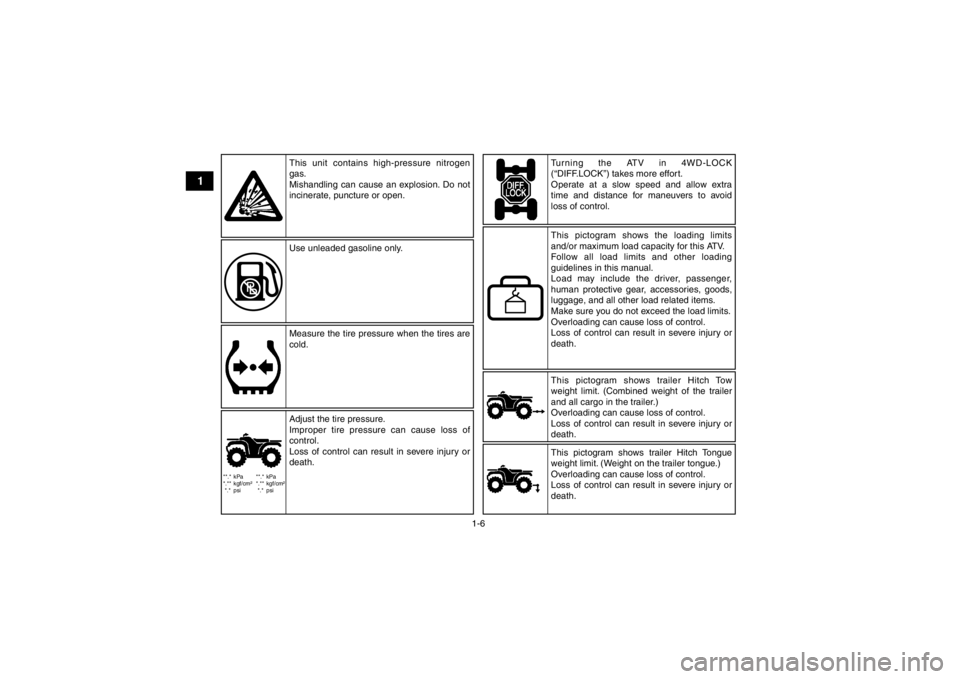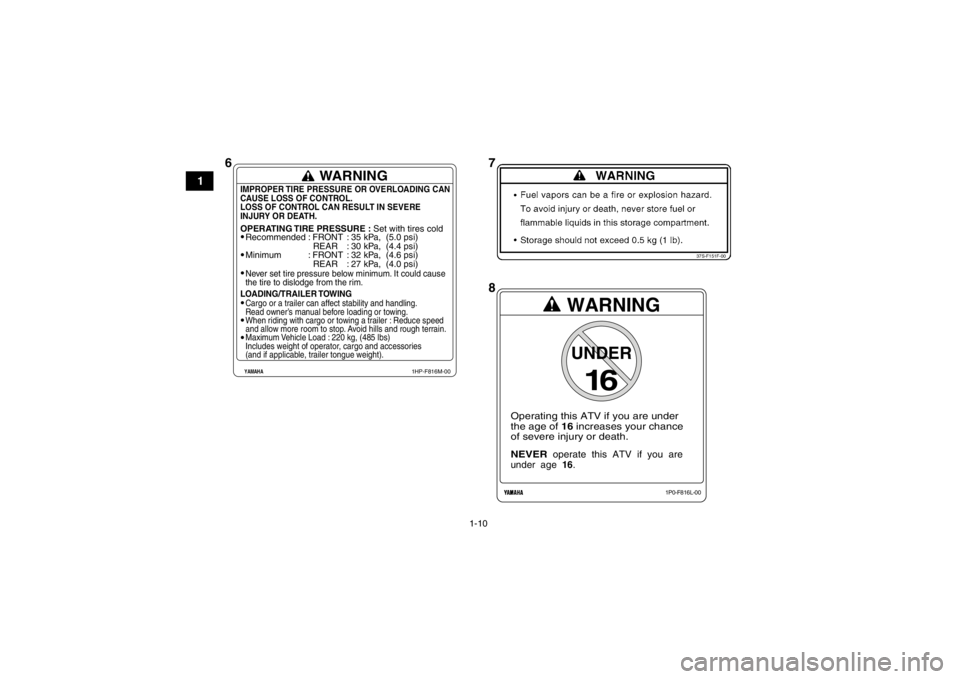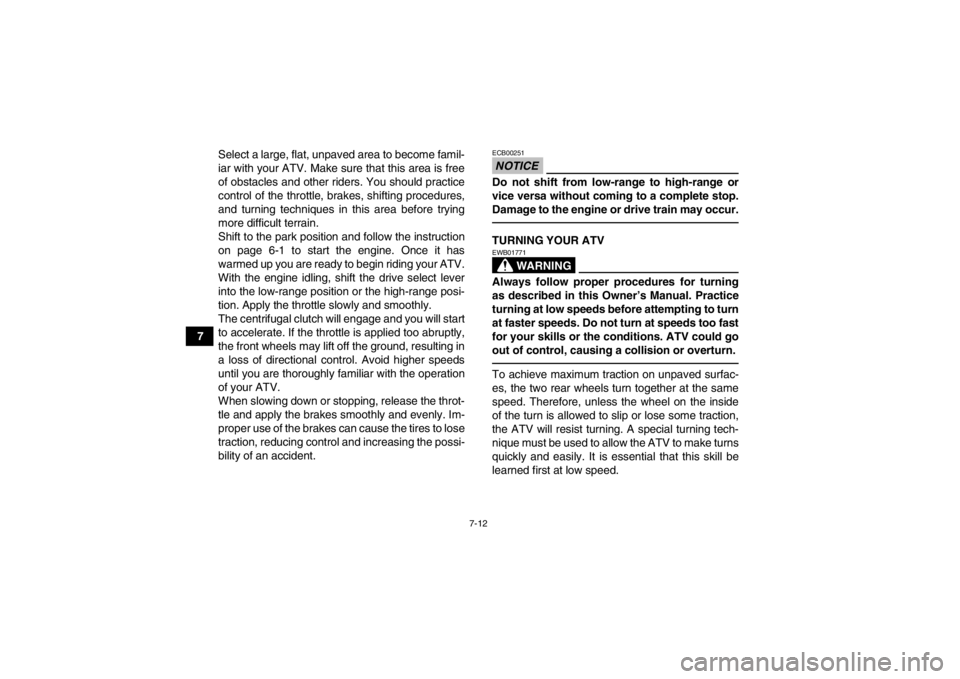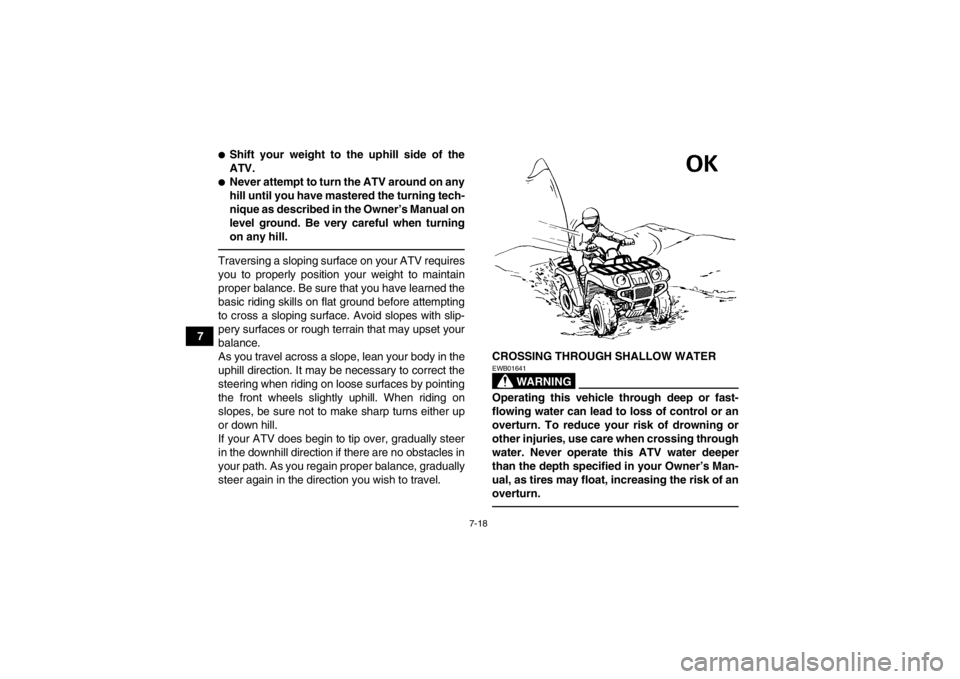tires YAMAHA GRIZZLY 700 2013 Owners Manual
[x] Cancel search | Manufacturer: YAMAHA, Model Year: 2013, Model line: GRIZZLY 700, Model: YAMAHA GRIZZLY 700 2013Pages: 174, PDF Size: 4.21 MB
Page 8 of 174

EBU17420
TABLE OF CONTENTS
LOCATION OF THE WARNING AND
SPECIFICATION LABELS ............................ 1-1
SAFETY INFORMATION .............................. 2-1
DESCRIPTION .............................................. 3-1Left view ...................................................... 3-1
Right view.................................................... 3-1
Controls and instruments ............................ 3-2
INSTRUMENT AND CONTROL
FUNCTIONS .................................................. 4-1 Main switch ................................................ 4-1
Indicator lights and warning lights .............. 4-2
Multi-function display .................................. 4-5
Handlebar switches .................................... 4-7
Throttle lever ............................................ 4-13
Speed limiter ............................................ 4-13
Front brake lever ...................................... 4-14
Brake pedal and rear brake lever ............. 4-14
Drive select lever ...................................... 4-15
Fuel tank cap ............................................ 4-15
Fuel .......................................................... 4-16
Seat .......................................................... 4-18 Storage compartments .............................4-18
Front carrier ..............................................4-21
Rear carrier ...............................................4-21
Adjusting the front and rear shock
absorber assemblies ...............................4-21
Auxiliary DC jack .......................................4-23
PRE-OPERATION CHECKS ..........................5-1 Fuel .............................................................5-3
Engine oil ....................................................5-3
Final gear oil ...............................................5-3
Differential gear oil ......................................5-3
Coolant .......................................................5-3
Front and rear brakes .................................5-3
Throttle lever ...............................................5-4
Tires ............................................................5-4
Chassis fasteners .......................................5-7
Instruments, lights and switches .................5-7
OPERATION...................................................6-1 Starting the engine ......................................6-1
Operating the drive select lever and driving in reverse ......................................6-2
Engine break-in ...........................................6-4U1HP61E0.book Page 1 Thursday, April 5, 2012 3:33 PM
Page 16 of 174

1-6
1
**.* kPa
*.** kgf/cm²*.* psi **.* kPa
*.** kgf/cm²
*.* psi
This pictogram shows trailer Hitch Tow
weight limit. (Combined weight of the trailer
and all cargo in the trailer.)
Overloading can cause loss of control.
Loss of control can result in severe injury or
death.
This unit contains high-pressure nitrogen
gas.
Mishandling can cause an explosion. Do not
incinerate, puncture or open.
Use unleaded gasoline only.
Measure the tire pressure when the tires are
cold. Turning the ATV in 4WD-LOCK
(“DIFF.LOCK”) takes more effort.
Operate at a slow speed and allow extra
time and distance for maneuvers to avoid
loss of control.
Adjust the tire pressure.
Improper tire pressure can cause loss of
control.
Loss of control can result in severe injury or
death. This pictogram shows the loading limits
and/or maximum load capacity for this ATV.
Follow all load limits and other loading
guidelines in this manual.
Load may include the driver, passenger,
human protective gear, accessories, goods,
luggage, and all other load related items.
Make sure you do not exceed the load limits.
Overloading can cause loss of control.
Loss of control can result in severe injury or
death.
This pictogram shows trailer Hitch Tongue
weight limit. (Weight on the trailer tongue.)
Overloading can cause loss of control.
Loss of control can result in severe injury or
death.
U1HP61E0.book Page 6 Thursday, April 5, 2012 3:33 PM
Page 20 of 174

1-10
1
37S-F151F-00
Recommended
Minimum: FRONT
REAR
: FRONT
REAR: 35 kPa, (5.0 psi)
: 30 kPa, (4.4 psi)
: 32 kPa, (4.6 psi)
: 27 kPa, (4.0 psi)Never set tire pressure below minimum. It could cause
the tire to dislodge from the rim.Cargo or a trailer can affect stability and handling.
Read owner’s manual before loading or towing.
When riding with cargo or towing a trailer : Reduce speed
and allow more room to stop. Avoid hills and rough terrain.
Maximum Vehicle Load : 220 kg, (485 lbs)
Includes weight of operator, cargo and accessories
(and if applicable, trailer tongue weight).
WARNING
1HP-F816M-00
YAMAHAIMPROPER TIRE PRESSURE OR OVERLOADING CAN
CAUSE LOSS OF CONTROL.
LOSS OF CONTROL CAN RESULT IN SEVERE
INJURY OR DEATH.OPERATING TIRE PRESSURE : Set with tires coldLOADING/TRAILER TOWING
WARNING
NEVER
operate this ATV if you are
under age 16.Operating this ATV if you are under
the age of 16 increases your chance
of severe injury or death.
16
UNDER
1P0-F816L-00
67
8
U1HP61E0.book Page 10 Thursday, April 5, 2012 3:33 PM
Page 24 of 174

2-3
2
●Always use proper procedures if you stall or roll
backwards when climbing a hill. To avoid stall-
ing, use the proper gear range and maintain a
steady speed when climbing a hill. If you stall or
roll backwards, follow the special procedure for
braking described in this manual. Dismount on
the uphill side or to a side if pointed straight up-
hill. Turn the ATV around and remount, following
the procedure described in this manual.●Always check for obstacles before operating in a
new area.●Never attempt to operate over large obstacles,
such as large rocks or fallen trees. Always follow
proper procedures when operating over obsta-
cles as described in this manual.●Always be careful when skidding or sliding.
Learn to safely control skidding or sliding by
practicing at low speeds and on level, smooth
terrain. On extremely slippery surfaces, such as
ice, go slowly and be very cautious in order to re-
duce the chance of skidding or sliding out of con-
trol.●Never operate an ATV in fast flowing water or in
water deeper than that recommended in this
manual. Remember that wet brakes may havereduced stopping ability. Test your brakes after
leaving water. If necessary, apply them several
times to let friction dry out the linings.
●Always be sure there are no obstacles or people
behind you when you operate in reverse. When
it is safe to proceed in reverse, go slowly.●Always use the size and type of tires specified in
this manual.●Always maintain proper tire pressure as de-
scribed in this manual.●Never exceed the stated load capacity for an
ATV. Cargo should be properly distributed and
securely attached. Reduce speed and follow in-
structions in this manual for carrying cargo or
pulling a trailer. Allow greater distance for brak-
ing.●Do not operate your ATV during darkness un-
less it is equipped with a properly functioning
headlight. Off-road riding is inherently danger-
ous and additionally, off-road trails do not have
streetlights to guide you.●Never maintain an ATV without proper knowl-
edge. Contact an authorized ATV dealer to in-
form you on basic ATV maintenance. Certain
maintenance can only be carried out by certified
staff.
U1HP61E0.book Page 3 Thursday, April 5, 2012 3:33 PM
Page 55 of 174

5-2
5
Front brake Check operation. If soft or spongy, have Yamaha dealer bleed hy-
draulic system.
Check brake pads for wear, and replace if necessary.
Check brake fluid level in reservoir, and add specified brake fluid to specified level if necessary.
Check hydraulic system for leakage. Correct if necessary. 5-3, 8-47, 8-48, 8-49
Rear brake Check operation. If soft or spongy, have Yamaha dealer bleed hy-
draulic system.
Check pedal free play, and adjust if necessary.
Check brake pads for wear, and replace if necessary.
Check brake fluid level in reservoir, and add specified brake fluid to specified level if necessary.
Check hydraulic system for leakage. Correct if necessary. 5-3, 8-47, 8-48, 8-49,
8-50
Throttle lever Make sure that operation is smooth. Lubricate cable and lever hous-
ing if necessary.
Check lever free play, and adjust if necessary. 5-4, 8-45
Control cables Make sure that operation is smooth. Lubricate if necessary. 8-53
Wheels and tires Check wheel condition, and replace if damaged.
Check tire condition and tread depth. Replace if necessary.
Check air pressure. Correct if necessary. 5-4
Brake pedal Make sure that operation is smooth. Lubricate pedal pivoting point if
necessary. 8-54
Brake levers Make sure that operation is smooth. Lubricate lever pivoting points if
necessary. 8-53
Axle boots Check for cracks or damage, and replace if necessary. 8-52
Chassis fasteners Make sure that all nuts, bolts and screws are properly tightened. 5-7
Instruments, lights and
switches Check operation, and correct if necessary. 5-7
ITEM ROUTINE PAGE
U1HP61E0.book Page 2 Thursday, April 5, 2012 3:33 PM
Page 57 of 174

5-4
5
Brake fluid leakage
Check to see if any brake fluid is leaking out of the
pipe joints or brake fluid reservoirs. Apply the
brakes firmly for one minute. If a lever moves slow-
ly inward, there may be a leak in the brake system.
If there is any leakage, the brake system should be
checked by a Yamaha dealer.
Brake operation
Test the brakes at slow speed after starting out to
make sure they are working properly. If the brakes
do not provide proper braking performance, check
the brake pads for wear. (See page 8-47.)
EBU19761Throttle lever Check the operation of the throttle lever. It must
open smoothly and spring back to the idle position
when released. Have a Yamaha dealer correct if
necessary.
EBU19814Tires Check tire pressure regularly to make sure it is at
the recommended specifications. Also check for
wear and damage.
Tire pressure
Use the low-pressure tire gauge to check and ad-
just tire pressures when the tires are cold. Tire
pressures must be equal on both sides.
WARNING! Operation of this vehicle with im- proper tire pressure may cause severe injury
or death from loss of control or rollover. Tire
pressure below the minimum specified could
also cause the tire to dislodge from the rim un-
der severe riding conditions.
[EWB02541]
Set tire
pressures to the following specifications:
Specified brake fluid:
DOT 4
U1HP61E0.book Page 4 Thursday, April 5, 2012 3:33 PM
Page 59 of 174

5-6
5
Tire information
This ATV is equipped with tubeless tires with
valves.
WARNING
EWB02551Use of improper tires on this ATV may cause
loss of control, increasing your risk of an acci-
dent.After extensive tests, only the tires listed below
have been approved for this model by Yamaha
Motor Manufacturing Corporation of America.1. Tire wear limit
Fro nt: Manufacturer/model:YFM700FAPD CHENG SHIN/C828
YFM700FAPSED CHENG SHIN/C828
YFM7FGD MAXXIS/MU19
YFM7FGPAD MAXXIS/MU19
YFM7FGPD MAXXIS/MU19
YFM7FGPHD MAXXIS/MU19
YFM7FGPLED MAXXIS/MU19
YFM7FGPSED MAXXIS/MU19
Size: AT25 x 8-12
Type: Tu b e l e s s
U1HP61E0.book Page 6 Thursday, April 5, 2012 3:33 PM
Page 60 of 174

5-7
5Aftermarket tires and rims
The tires and rims that came with your ATV were
designed to match the performance capabilities
and to provide the best combination of handling,
braking, and comfort. Other tires, rims, sizes, and
combinations may not be appropriate.
EBU19840Chassis fasteners Make sure that all nuts, bolts and screws are prop-
erly tightened.
EBU19850Instruments, lights and switches Check that all instruments, lights and switches are
working properly. Correct if necessary.
Rear:
Manufacturer/model:YFM700FAPD CHENG SHIN/C828
YFM700FAPSED CHENG SHIN/C828
YFM7FGD MAXXIS/MU20
YFM7FGPAD MAXXIS/MU20
YFM7FGPD MAXXIS/MU20
YFM7FGPHD MAXXIS/MU20
YFM7FGPLED MAXXIS/MU20
YFM7FGPSED MAXXIS/MU20
Size: AT 2 5 x 1 0 - 1 2
Ty p e : Tu b e l e s s
U1HP61E0.book Page 7 Thursday, April 5, 2012 3:33 PM
Page 80 of 174

7-12
7Select a large, flat, unpaved area to become famil-
iar with your ATV. Make sure that this area is free
of obstacles and other riders. You should practice
control of the throttle, brakes, shifting procedures,
and turning techniques in this area before trying
more difficult terrain.
Shift to the park position and follow the instruction
on page 6-1 to start the engine. Once it has
warmed up you are ready to begin riding your ATV.
With the engine idling, shift the drive select lever
into the low-range position or the high-range posi-
tion. Apply the throttle slowly and smoothly.
The centrifugal clutch will engage and you will start
to accelerate. If the throttle is applied too abruptly,
the front wheels may lift off the ground, resulting in
a loss of directional control. Avoid higher speeds
until you are thoroughly familiar with the operation
of your ATV.
When slowing down or stopping, release the throt-
tle and apply the brakes smoothly and evenly. Im-
proper use of the brakes can cause the tires to lose
traction, reducing control and increasing the possi-
bility of an accident.
NOTICEECB00251Do not shift from low-range to high-range or
vice versa without coming to a complete stop.
Damage to the engine or drive train may occur.TURNING YOUR ATV
WARNING
EWB01771Always follow proper procedures for turning
as described in this Owner’s Manual. Practice
turning at low speeds before attempting to turn
at faster speeds. Do not turn at speeds too fast
for your skills or the conditions. ATV could go
out of control, causing a collision or overturn.To achieve maximum traction on unpaved surfac-
es, the two rear wheels turn together at the same
speed. Therefore, unless the wheel on the inside
of the turn is allowed to slip or lose some traction,
the ATV will resist turning. A special turning tech-
nique must be used to allow the ATV to make turns
quickly and easily. It is essential that this skill be
learned first at low speed.
U1HP61E0.book Page 12 Thursday, April 5, 2012 3:33 PM
Page 86 of 174

7-18
7
●Shift your weight to the uphill side of the
ATV.●Never attempt to turn the ATV around on any
hill until you have mastered the turning tech-
nique as described in the Owner’s Manual on
level ground. Be very careful when turning
on any hill.Traversing a sloping surface on your ATV requires
you to properly position your weight to maintain
proper balance. Be sure that you have learned the
basic riding skills on flat ground before attempting
to cross a sloping surface. Avoid slopes with slip-
pery surfaces or rough terrain that may upset your
balance.
As you travel across a slope, lean your body in the
uphill direction. It may be necessary to correct the
steering when riding on loose surfaces by pointing
the front wheels slightly uphill. When riding on
slopes, be sure not to make sharp turns either up
or down hill.
If your ATV does begin to tip over, gradually steer
in the downhill direction if there are no obstacles in
your path. As you regain proper balance, gradually
steer again in the direction you wish to travel.CROSSING THROUGH SHALLOW WATER
WARNING
EWB01641Operating this vehicle through deep or fast-
flowing water can lead to loss of control or an
overturn. To reduce your risk of drowning or
other injuries, use care when crossing through
water. Never operate this ATV water deeper
than the depth specified in your Owner’s Man-
ual, as tires may float, increasing the risk of an
overturn.
U1HP61E0.book Page 18 Thursday, April 5, 2012 3:33 PM